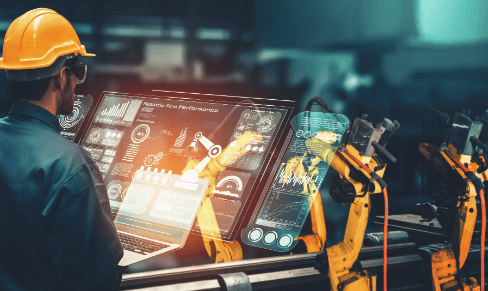Remember when manufacturing was all about assembly lines and manual labor? Those days are long gone. Today’s factories are buzzing with smart tech, and it’s not just about robots welding car parts anymore. We’re talking about a whole new ballgame where IT solutions for manufacturing companies are changing the game.
The Smart Factory: More Than Just Machines
Picture this: You walk into a modern factory, and instead of the clang and clatter of old-school machinery, you hear the quiet hum of computers and see workers tapping away on tablets. It’s not science fiction – it’s the reality of smart manufacturing.
But what’s driving this change? Let’s break it down:
- Data, data everywhere: Factories are now collecting more data than ever before. It’s like they’ve gone from using a notepad to having a supercomputer in their pocket. Every machine, every process, every product is spitting out data faster than you can say “big data analytics.”
- Internet of Things (IoT): Machines aren’t just dumb hunks of metal anymore. They’re chatting with each other and sharing info like gossip at the water cooler. Sensors are everywhere, monitoring everything from temperature to vibration, giving us insights we never had before.
- Artificial Intelligence (AI): It’s not just for beating humans at chess. AI is now helping factories make decisions faster than you can say “production line.” It’s predicting maintenance needs, optimizing production schedules, and even helping design better products.
See also: Tech Industry Marketing Tactics to Grow Your Company
The Secret Sauce: IT Solutions for Manufacturing Companies
Now, you might be thinking, “That’s all well and good, but how does it actually work?” Well, buckle up, because we’re about to dive into the nitty-gritty of IT solutions in manufacturing.
Enterprise Resource Planning (ERP): The Brain of the Operation
Think of ERP as the factory’s central nervous system. It’s keeping track of everything from inventory to HR, making sure all the parts of the business are talking to each other. Without it, you’d have chaos – like trying to organize a birthday party for triplets without a plan.
But modern ERP systems are so much more than glorified spreadsheets. They’re using AI to predict demand, optimize inventory levels, and even suggest process improvements. It’s like having a crystal ball and a team of efficiency experts all rolled into one.
Manufacturing Execution Systems (MES): The Taskmaster
If ERP is the brain, then MES is the bossy manager making sure everyone’s doing their job. It’s tracking production in real-time, quality control, and making sure deadlines are met. It’s like having a super-efficient, never-sleeping supervisor on the factory floor.
MES systems are getting smarter by the day. They’re not just tracking what’s happening; they’re predicting what’s going to happen next. Spotted a potential quality issue? The MES is already on it, adjusting processes before a single defective product rolls off the line.
Supply Chain Management (SCM): The Juggler
Managing a supply chain is like trying to juggle while riding a unicycle – on a tightrope. SCM software helps keep all those balls in the air, tracking everything from raw materials to finished products. It’s making sure you don’t run out of widgets when you need them most.
But modern SCM systems are doing more than just tracking. They’re using AI to predict disruptions, suggest alternative suppliers, and even optimize shipping routes. It’s like having a supply chain psychic on speed dial.
The Human Touch in a Digital World
Now, I know what you’re thinking. “All this tech sounds great, but what about the people?” It’s a fair question. After all, we’re not trying to create robot overlords here.
Upskilling: Teaching Old Dogs New Tricks
The truth is, IT solutions for manufacturing companies aren’t about replacing humans – they’re about making them superheroes. We’re talking about giving workers new skills, like:
- Data analysis: Turning factory floor workers into data detectives
- Software operation: Making machine operators into tech wizards
- Problem-solving: Empowering everyone to think like an engineer
But it’s not just about learning to use new tools. It’s about changing the way we think about manufacturing. We’re moving from reactive to proactive, from following instructions to making decisions. It’s a whole new mindset, and it’s exciting stuff.
Collaboration: Bringing Everyone to the Table
Smart manufacturing isn’t just about fancy gadgets – it’s about bringing people together. IT solutions are helping break down walls between departments faster than you can say “interdepartmental memo.”
Imagine a world where the design team can instantly see how their changes affect manufacturing costs. Where the maintenance team can predict a machine failure before it happens. Where the sales team knows exactly when a custom order will be ready. That’s the power of collaboration in smart manufacturing.
The Challenges: It’s Not All Smooth Sailing
Look, I’m not gonna sugarcoat it. Implementing IT solutions in manufacturing isn’t always a walk in the park. There are some hurdles to jump:
- Cost: Let’s face it, this stuff ain’t cheap. But think of it as an investment, not an expense. The ROI can be huge if you do it right.
- Resistance to change: Some folks are set in their ways. Convincing Joe from accounting that his spreadsheets are outdated can be tougher than getting a cat to take a bath. It takes patience, training, and sometimes a bit of hand-holding.
- Security concerns: With great data comes great responsibility. Keeping all that info safe is a full-time job in itself. Cybersecurity in manufacturing isn’t just about protecting trade secrets anymore – it’s about preventing hackers from taking control of your production line.
- Integration headaches: Getting all these systems to play nice together can be like herding cats. Legacy systems, different data formats, incompatible interfaces – it’s enough to give your IT team nightmares.
The Future: What’s Next for Smart Manufacturing?
So, where do we go from here? Well, if I had a crystal ball, I’d be making a fortune on Wall Street. But I can make some educated guesses:
5G and Edge Computing: Faster Than a Speeding Bullet
5G isn’t just for streaming cat videos faster. In manufacturing, it’s going to enable real-time decision making that’ll make your head spin. And edge computing? It’s bringing processing power right to the factory floor, faster than you can say “low latency.”
Imagine robots that can react to their environment in milliseconds. Quality control systems that can spot defects in real-time. Maintenance systems that can predict failures before they happen. It’s going to be a game-changer.
Digital Twins: The Virtual Doppelganger
Imagine having a virtual copy of your entire factory that you can play with. That’s what digital twins are all about. It’s like having a sandbox where you can test out new ideas without risking your actual production line.
Want to see how a new production line would work? Fire up the digital twin. Need to train new operators? Let them practice on the virtual factory. It’s like having a time machine for your manufacturing process.
Augmented Reality (AR): See the Invisible
AR isn’t just for catching Pokémon. In manufacturing, it’s helping workers see inside machines, follow complex assembly instructions, and even get remote expert help. It’s like giving everyone x-ray vision and a genius sidekick.
Picture this: A maintenance worker puts on AR glasses and instantly sees which parts of a machine need attention. An assembly line worker looks at a complex part and sees step-by-step instructions floating in the air. A manager walks the factory floor and sees real-time production data hovering over each workstation. The possibilities are endless.
Wrapping It Up: The Smart Manufacturing Revolution
At the end of the day, IT solutions for manufacturing companies are more than just buzzwords or fancy tech. They’re about making factories smarter, safer, and more efficient. It’s about empowering workers, not replacing them. And most importantly, it’s about staying competitive in a world that’s changing faster than ever.
We’re on the cusp of a new industrial revolution, folks. And just like the first one, it’s going to change everything. But this time, instead of steam engines and assembly lines, we’ve got AI, IoT, and more acronyms than you can shake a stick at.







